Comparison of Anti-Inflammatory and Antibacterial Properties of Raphanus sativus L. Leaf and Root Kombucha-Fermented Extracts
Abstract
:1. Introduction
2. Results and Discussion
2.1. Determination of Bioactive Compounds
2.2. Assessment of Antioxidant Activity
2.2.1. ABTS and DPPH Radical Scavenging
2.2.2. Intracellular ROS Levels in Skin Cells
2.3. Cytotoxicity Assessment
2.4. Assessment of Anti-Inflammatory Activity
2.5. Assessment of Antibacterial Activity
2.6. Transepidermal Water Loss (TEWL) and Skin Hydration Measurements
3. Materials and Methods
3.1. Plant Material and Fermentation Procedure
3.2. Determination of Biologically Active Compounds
3.3. Assessment of Antioxidant Activity
3.3.1. DPPH Radical Scavenging Assay
3.3.2. ABTS Scavenging Assay
3.3.3. Detection of Intracellular Levels of Reactive Oxygen Species (ROS)
3.4. Cytotoxicity Analysis
3.4.1. Cell Culture
3.4.2. Alamar Blue Assay
3.4.3. Neutral Red Assay
3.5. Assessment of Anti-Inflammatory Activity
3.6. Assessment of Antibacterial Activity
3.7. Transepidermal Water Loss (TEWL) and Skin Hydration Measurements
3.8. Statistical Analysis
4. Conclusions
Supplementary Materials
Author Contributions
Funding
Institutional Review Board Statement
Informed Consent Statement
Data Availability Statement
Conflicts of Interest
References
- Ferreira, M.S.; Magalhães, M.C.; Oliveira, R.; Sousa-Lobo, J.M.; Almeida, I.F. Trends in the Use of Botanicals in Anti-Aging Cosmetics. Molecules 2021, 26, 3584. [Google Scholar] [CrossRef] [PubMed]
- Hoang, H.T.; Moon, J.-Y.; Lee, Y.-C. Natural Antioxidants from Plant Extracts in Skincare Cosmetics: Recent Applications, Challenges and Perspectives. Cosmetics 2021, 8, 106. [Google Scholar] [CrossRef]
- Yahya, N.A.; Attan, N.; Wahab, R.A. An overview of cosmeceutically relevant plant extracts and strategies for extraction of plant-based bioactive compounds. Food Bioprod. Process. 2018, 112, 69–85. [Google Scholar] [CrossRef]
- Majchrzak, W.; Motyl, I.; Śmigielski, K. Biological and Cosmetical Importance of Fermented Raw Materials: An Overview. Molecules 2022, 27, 4845. [Google Scholar] [CrossRef] [PubMed]
- Yoseph, C.; Avanti, C.; Hadiwidjaja, M.; Briliani, K. The Importance of Fermented Active for Anti Aging Incosmetics Product—Ubaya Repository. Available online: http://repository.ubaya.ac.id/39898/ (accessed on 22 April 2024).
- Jayabalan, R.; Marimuthu, S.; Swaminathan, K. Changes in content of organic acids and tea polyphenols during kombucha tea fermentation. Food Chem. 2007, 102, 392–398. [Google Scholar] [CrossRef]
- Villarreal-Soto, S.A.; Beaufort, S.; Bouajila, J.; Souchard, J.; Taillandier, P. Understanding Kombucha Tea Fermentation: A Review. J. Food Sci. 2018, 83, 580–588. [Google Scholar] [CrossRef] [PubMed]
- Watawana, M.I.; Jayawardena, N.; Gunawardhana, C.B.; Waisundara, V.Y. Health, Wellness, and Safety Aspects of the Consumption of Kombucha. J. Chem. 2015, 2015, 591869. [Google Scholar] [CrossRef]
- Bauer-Petrovska, B.; Petrushevska-Tozi, L. Mineral and water soluble vitamin content in the Kombucha drink. Int. J. Food Sci. Technol. 2000, 35, 201–205. [Google Scholar] [CrossRef]
- Malbaša, R.V.; Lončar, E.S.; Vitas, J.S.; Čanadanović-Brunet, J.M. Influence of starter cultures on the antioxidant activity of kombucha beverage. Food Chem. 2011, 127, 1727–1731. [Google Scholar] [CrossRef]
- Gaggìa, F.; Baffoni, L.; Galiano, M.; Nielsen, D.S.; Jakobsen, R.R.; Castro-Mejía, J.L.; Bosi, S.; Truzzi, F.; Musumeci, F.; Dinelli, G.; et al. Kombucha Beverage from Green, Black and Rooibos Teas: A Comparative Study Looking at Microbiology, Chemistry and Antioxidant Activity. Nutrients 2018, 11, 1. [Google Scholar] [CrossRef]
- Kapp, J.M.; Sumner, W. Kombucha: A systematic review of the empirical evidence of human health benefit. Ann. Epidemiol. 2019, 30, 66–70. [Google Scholar] [CrossRef] [PubMed]
- Ivanisova, E.; Menhartova, K.; Terentjeva, M.; Harangozo, L.; Kantor, A.; Kacaniova, M. The evaluation of chemical, antioxidant, antimicrobial and sensory properties of kombucha tea beverage. J. Food Sci. Technol. 2020, 57, 1840–1846. [Google Scholar] [CrossRef] [PubMed]
- Goyeneche, R.; Roura, S.; Ponce, A.; Vega-Gálvez, A.; Quispe-Fuentes, I.; Uribe, E.; Di Scala, K. Chemical characterization and antioxidant capacity of red radish (Raphanus sativus L.) leaves and roots. J. Funct. Foods 2015, 16, 256–264. [Google Scholar] [CrossRef]
- Malik, M.S.; Riley, M.B.; Norsworthy, J.K.; Bridges, W. Variation of Glucosinolates in Wild Radish (Raphanus raphanistrum) Accessions. J. Agric. Food Chem. 2010, 58, 11626–11632. [Google Scholar] [CrossRef] [PubMed]
- Gamba, M.; Asllanaj, E.; Raguindin, P.F.; Glisic, M.; Franco, O.H.; Minder, B.; Bussler, W.; Metzger, B.; Kern, H.; Muka, T. Nutritional and phytochemical characterization of radish (Raphanus sativus): A systematic review. Trends Food Sci. Technol. 2021, 113, 205–218. [Google Scholar] [CrossRef]
- Kim, S.; Woo, M.; Kim, M.; Noh, J.S.; Song, Y.O. Hot water extracts of pressure-roasted dried radish attenuates hepatic oxidative stress via Nrf2 up-regulation in mice fed high-fat diet. Food Sci. Biotechnol. 2017, 26, 1063–1069. [Google Scholar] [CrossRef]
- Shin, T.; Ahn, M.; Kim, G.O.; Park, S.U. Biological activity of various radish species. Orient. Pharm. Exp. Med. 2015, 15, 105–111. [Google Scholar] [CrossRef]
- Kim, K.H.; Moon, E.; Kim, S.Y.; Choi, S.U.; Lee, J.H.; Lee, K.R. 4-Methylthio-butanyl derivatives from the seeds of Raphanus sativus and their biological evaluation on anti-inflammatory and antitumor activities. J. Ethnopharmacol. 2014, 151, 503–508. [Google Scholar] [CrossRef]
- Gutiérrez, R.M.P.; Perez, R.L. Raphanus sativus (Radish): Their Chemistry and Biology. Sci. World J. 2004, 4, 811–837. [Google Scholar] [CrossRef]
- Rakhmawati, R.; Anggarwulan, E.; Retnaningtyas, E. Potency of Lobak Leaves (Raphanus sativus L. var. hortensis Back) as Anticancer and Antimicrobial Candidates. Biodivers. J. Biol. Divers. 2008, 10, d100310. [Google Scholar] [CrossRef]
- Roh, S.-S.; Park, S.-B.; Park, S.-M.; Choi, B.W.; Lee, M.-H.; Hwang, Y.-L.; Jeong, H.-A.; Kim, C.D.; Lee, J.-H. A Novel Compound Rasatiol Isolated from Raphanus sativus Has a Potential to Enhance Extracellular Matrix Synthesis in Dermal Fibroblasts. Ann. Dermatol. 2013, 25, 315–320. [Google Scholar] [CrossRef] [PubMed]
- Puebla-Barragan, S.; Reid, G. Probiotics in Cosmetic and Personal Care Products: Trends and Challenges. Molecules 2021, 26, 1249. [Google Scholar] [CrossRef]
- Enkhtuya, E.; Tsend, M. The effect of peeling on antioxidant capacity of black radish root. Italian J. Food Sci. 2020, 32, 701–711. [Google Scholar] [CrossRef]
- Shukla, S.; Chatterji, S.; Yadav, D.K.; Watal, G. Antimicrobial efficacy of Raphanus sativus root juice. Int. J. Pharm. Pharm. Sci. 2011, 3, 89–92. [Google Scholar]
- Duy, H.H.; Ngoc, P.T.K.; Anh, L.T.H.; Dao, D.T.A.; Nguyen, D.C.; Than, V.T. In Vitro Antifungal Efficacy of White Radish (Raphanus sativus L.) Root Extract and Application as a Natural Preservative in Sponge Cake. Processes 2019, 7, 549. [Google Scholar] [CrossRef]
- Tamang, J.P.; Sarkar, P.K. Sinki: A traditional lactic acid fermented radish tap root product. J. Gen. Appl. Microbiol. 1993, 39, 395–408. [Google Scholar] [CrossRef]
- Vedamuthu, E. The Dairy Leuconostoc: Use in Dairy Products. J. Dairy Sci. 1994, 77, 2725–2737. [Google Scholar] [CrossRef]
- Luo, X.; Zhang, H.; Duan, Y.; Chen, G. Protective effects of radish (Raphanus sativus L.) leaves extract against hydrogen peroxide-induced oxidative damage in human fetal lung fibroblast (MRC-5) cells. Biomed. Pharmacother. 2018, 103, 406–414. [Google Scholar] [CrossRef] [PubMed]
- Cannavacciuolo, C.; Cerulli, A.; Dirsch, V.M.; Heiss, E.H.; Masullo, M.; Piacente, S. LC-MS- and 1H NMR-Based Metabolomics to Highlight the Impact of Extraction Solvents on Chemical Profile and Antioxidant Activity of Daikon Sprouts (Raphanus sativus L.). Antioxidants 2023, 12, 1542. [Google Scholar] [CrossRef]
- Beevi, S.S.; Narasu, M.L.; Gowda, B.B. Polyphenolics Profile, Antioxidant and Radical Scavenging Activity of Leaves and Stem of Raphanus sativus L. Plant Foods Hum. Nutr. 2010, 65, 8–17. [Google Scholar] [CrossRef]
- Beevi, S.S.; Mangamoori, L.N.; Gowda, B.B. Polyphenolics profile and antioxidant properties of Raphanus sativus L. Nat. Prod. Res. 2012, 26, 557–563. [Google Scholar] [CrossRef] [PubMed]
- Jakubczyk, K.; Gutowska, I.; Antoniewicz, J.; Janda, K. Evaluation of Fluoride and Selected Chemical Parameters in Kombucha Derived from White, Green, Black and Red Tea. Biol. Trace Element Res. 2020, 199, 3547–3552. [Google Scholar] [CrossRef] [PubMed]
- Hayes, J.D.; Dinkova-Kostova, A.T.; Tew, K.D. Oxidative Stress in Cancer. Cancer Cell 2020, 38, 167–197. [Google Scholar] [CrossRef] [PubMed]
- Michalak, M. Plant-Derived Antioxidants: Significance in Skin Health and the Ageing Process. Int. J. Mol. Sci. 2022, 23, 585. [Google Scholar] [CrossRef] [PubMed]
- Manach, C.; Scalbert, A.; Morand, C.; Rémésy, C.; Jiménez, L. Polyphenols: Food sources and bioavailability. Am. J. Clin. Nutr. 2004, 79, 727–747. [Google Scholar] [CrossRef] [PubMed]
- Ziemlewska, A.; Nizioł-Łukaszewska, Z.; Zagórska-Dziok, M.; Wójciak, M.; Szczepanek, D.; Sowa, I. Assessment of Cosmetic and Dermatological Properties and Safety of Use of Model Skin Tonics with Kombucha-Fermented Red Berry Extracts. Int. J. Mol. Sci. 2022, 23, 14675. [Google Scholar] [CrossRef] [PubMed]
- Pantelidis, G.E.; Vasilakakis, M.; Manganaris, G.A.; Diamantidis, G. Antioxidant capacity, phenol, anthocyanin and ascorbic acid contents in raspberries, blackberries, red currants, gooseberries and Cornelian cherries. Food Chem. 2007, 102, 777–783. [Google Scholar] [CrossRef]
- Lugasi, A.; Blázovics, A.; Hagymási, K.; Kocsis, I.; Kéry, Á. Antioxidant effect of squeezed juice from black radish (Raphanus sativus L. var niger) in alimentary hyperlipidaemia in rats. Phytother. Res. 2005, 19, 587–591. [Google Scholar] [CrossRef] [PubMed]
- Katsuzaki, H.; Miyahara, Y.; Ota, M.; Imai, K.; Komiya, T. Chemistry and antioxidative activity of hot water extract of Japanese radish (daikon). BioFactors 2004, 21, 211–214. [Google Scholar] [CrossRef]
- Vig, A.P.; Rampal, G.; Thind, T.S.; Arora, S. Bio-protective effects of glucosinolates—A review. LWT-Food Sci. Technol. 2009, 42, 1561–1572. [Google Scholar] [CrossRef]
- Girsang, E.; Lister, I.N.E.; Ginting, C.N.; Sholihah, I.A.; Raif, M.A.; Kunardi, S.; Million, H.; Widowati, W. Antioxidant and antiaging activity of rutin and caffeic acid. Pharmaciana 2020, 10, 147–156. [Google Scholar] [CrossRef]
- Bae, J.; Kim, N.; Shin, Y.; Kim, S.-Y.; Kim, Y.-J. Activity of catechins and their applications. Biomed. Dermatol. 2020, 4, 8. [Google Scholar] [CrossRef]
- Alonso, C.; Martí, M.; Barba, C.; Lis, M.; Rubio, L.; Coderch, L. Skin penetration and antioxidant effect of cosmeto-textiles with gallic acid. J. Photochem. Photobiol. B Biol. 2016, 156, 50–55. [Google Scholar] [CrossRef] [PubMed]
- Lupu, M.-A.; Pircalabioru, G.G.; Chifiriuc, M.-C.; Albulescu, R.; Tanase, C. Beneficial effects of food supplements based on hydrolyzed collagen for skin care (Review). Exp. Ther. Med. 2019, 20, 12–17. [Google Scholar] [CrossRef] [PubMed]
- Sivamaruthi, B.S.; Chaiyasut, C.; Kesika, P. Cosmeceutical importance of fermented plant extracts: A short review. Int. J. Appl. Pharm. 2018, 10, 31–34. [Google Scholar] [CrossRef]
- Mosser, D.M.; Edwards, J.P. Exploring the full spectrum of macrophage activation. Nat. Rev. Immunol. 2008, 8, 958–969. [Google Scholar] [CrossRef]
- de Oliveira, R.G.; Damazo, A.S.; Antonielli, L.F.; Miyajima, F.; Pavan, E.; Duckworth, C.A.; Lima, J.C.d.S.; Arunachalam, K.; Martins, D.T.d.O. Dilodendron bipinnatum Radlk. extract alleviates ulcerative colitis induced by TNBS in rats by reducing inflammatory cell infiltration, TNF-α and IL-1β concentrations, IL-17 and COX-2 expressions, supporting mucus production and promotes an antioxidant effect. J. Ethnopharmacol. 2021, 269, 113735. [Google Scholar] [CrossRef]
- Jeon, H.; Yang, D.; Lee, N.H.; Ahn, M.; Kim, G. Inhibitory Effect of Black Radish (Raphanus sativus L. var. niger) Extracts on Lipopolysaccharide-Induced Inflammatory Response in the Mouse Monocyte/Macrophage-Like Cell Line RAW 264.7. Prev. Nutr. Food Sci. 2020, 25, 408–421. [Google Scholar] [CrossRef] [PubMed]
- Park, H.-J.; Song, M. Leaves of Raphanus sativus L. Shows Anti-Inflammatory Activity in LPS-Stimulated Macrophages via Suppression of COX-2 and iNOS Expression. Prev. Nutr. Food Sci. 2017, 22, 50–55. [Google Scholar] [CrossRef]
- Jin, H.-G.; Ko, H.J.; Chowdhury, A.; Lee, D.-S.; Woo, E.-R. A new indole glycoside from the seeds of Raphanus sativus. Arch. Pharmacal Res. 2016, 39, 755–761. [Google Scholar] [CrossRef]
- Kim, K.H.; Kim, C.S.; Park, Y.J.; Moon, E.; Choi, S.U.; Lee, J.H.; Kim, S.Y.; Lee, K.R. Anti-inflammatory and antitumor phenylpropanoid sucrosides from the seeds of Raphanus sativus. Bioorg. Med. Chem. Lett. 2015, 25, 96–99. [Google Scholar] [CrossRef] [PubMed]
- Kook, S.-H.; Choi, K.-C.; Lee, Y.-H.; Cho, H.-K.; Lee, J.-C. Raphanus sativus L. seeds prevent LPS-stimulated inflammatory response through negative regulation of the p38 MAPK-NF-κB pathway. Int. Immunopharmacol. 2014, 23, 726–734. [Google Scholar] [CrossRef] [PubMed]
- Stanikunaite, R.; Khan, S.I.; Trappe, J.M.; Ross, S.A. Cyclooxygenase-2 inhibitory and antioxidant compounds from the truffle Elaphomyces granulatus. Phytother. Res. 2008, 23, 575–578. [Google Scholar] [CrossRef]
- Lesjak, M.; Beara, I.; Simin, N.; Pintac, D.; Majkic, T.; Bekvalac, K.; Orcic, D.; Mimica-Dukic, N. Antioxidant and anti-inflammatory activities of quercetin and its derivatives. J. Funct. Foods 2018, 40, 68–75. [Google Scholar] [CrossRef]
- Mueller, M.; Hobiger, S.; Jungbauer, A. Anti-inflammatory activity of extracts from fruits, herbs and spices. Food Chem. 2010, 122, 987–996. [Google Scholar] [CrossRef]
- Yoon, H.-Y.; Lee, E.-G.; Lee, H.; Cho, I.J.; Choi, Y.J.; Sung, M.-S.; Yoo, H.-G.; Yoo, W.-H. Kaempferol inhibits IL-1β-induced proliferation of rheumatoid arthritis synovial fibroblasts and the production of COX-2, PGE2 and MMPs. Int. J. Mol. Med. 2013, 32, 971–977. [Google Scholar] [CrossRef] [PubMed]
- Sekiguchi, A.; Motegi, S.-I.; Fujiwara, C.; Yamazaki, S.; Inoue, Y.; Uchiyama, A.; Akai, R.; Iwawaki, T.; Ishikawa, O. Inhibitory effect of kaempferol on skin fibrosis in systemic sclerosis by the suppression of oxidative stress. J. Dermatol. Sci. 2019, 96, 8–17. [Google Scholar] [CrossRef] [PubMed]
- Lee, S.; Yu, J.S.; Phung, H.M.; Lee, J.G.; Kim, K.H.; Kang, K.S. Potential Anti-Skin Aging Effect of (-)-Catechin Isolated from the Root Bark of Ulmus davidiana var. japonica in Tumor Necrosis Factor-α-Stimulated Normal Human Dermal Fibroblasts. Antioxidants 2020, 9, 981. [Google Scholar] [CrossRef]
- Choi, J.W.; Lee, J.; Park, Y.I. 7,8-Dihydroxyflavone attenuates TNF-α-induced skin aging in Hs68 human dermal fibroblast cells via down-regulation of the MAPKs/Akt signaling pathways. Biomed. Pharmacother. 2017, 95, 1580–1587. [Google Scholar] [CrossRef]
- Halla, N.; Fernandes, I.P.; Heleno, S.A.; Costa, P.; Boucherit-Otmani, Z.; Boucherit, K.; Rodrigues, A.E.; Ferreira, I.C.F.R.; Barreiro, M.F. Cosmetics Preservation: A Review on Present Strategies. Molecules 2018, 23, 1571. [Google Scholar] [CrossRef]
- Rathour, S.; Ghosh, K. Phytochemical Analysis, Antioxidant and Antimicrobial Activity of Raphanus Sativus and Citrus Limon Peel. Int. J. Bot. Stud. 2020, 5, 452–456. [Google Scholar]
- da Silva, A.F.; Lopes, M.d.O.; Cerdeira, C.D.; Ribeiro, I.S.; Rosa, I.A.; Chavasco, J.K.; da Silva, M.A.; Marques, M.J.; da Silva, G.A. Study and evaluation of antimicrobial activity and antioxidant capacity of dry extract and fractions of leaves of Raphanus sativus var. oleiferus Metzg. Biosci. J. 2020, 36, 606–618. [Google Scholar] [CrossRef]
- Jadoun, J.; Yazbak, A.; Rushrush, S.; Rudy, A.; Azaizeh, H. Identification of a New Antibacterial Sulfur Compound from Raphanus sativus Seeds. Evid.-Based Complement. Altern. Med. 2016, 2016, 9271285. [Google Scholar] [CrossRef]
- Cowan, M.M. Plant Products as Antimicrobial Agents. Clin. Microbiol. Rev. 1999, 12, 564–582. [Google Scholar] [CrossRef] [PubMed]
- Ahmad, H.; Faiyaz Ahmad, B.; Hasan, I.; Kamal Chishti, D.; Ahmad Govt Nizamia Tibbi College, H. Antibacterial Activity of Raphanus Sativus Linn. Seed Extrac; Global Journals Inc.: Framingham, MA, USA, 2012; Volume 12. [Google Scholar]
- Sevindik, M.; Onat, C.; Mohammed, F.S.; Uysal, I.; Koçer, O. Antioxidant and antimicrobial activities of White Radish. Turk. J. Agric. Food Sci. Technol. 2023, 11, 372–375. [Google Scholar] [CrossRef]
- Alizadeh-Sani, M.; Tavassoli, M.; McClements, D.J.; Hamishehkar, H. Multifunctional halochromic packaging materials: Saffron petal anthocyanin loaded-chitosan nanofiber/methyl cellulose matrices. Food Hydrocoll. 2020, 111, 106237. [Google Scholar] [CrossRef]
- Nikmaram, N.; Budaraju, S.; Barba, F.J.; Lorenzo, J.M.; Cox, R.B.; Mallikarjunan, K.; Roohinejad, S. Application of plant extracts to improve the shelf-life, nutritional and health-related properties of ready-to-eat meat products. Meat Sci. 2018, 145, 245–255. [Google Scholar] [CrossRef] [PubMed]
- Campolina, G.A.; Cardoso, M.d.G.; Caetano, A.R.S.; Nelson, D.L.; Ramos, E.M. Essential Oil and Plant Extracts as Preservatives and Natural Antioxidants Applied to Meat and Meat Products: A Review. Food Technol. Biotechnol. 2023, 61, 212–225. [Google Scholar] [CrossRef]
- da Silva, B.D.; Bernardes, P.C.; Pinheiro, P.F.; Fantuzzi, E.; Roberto, C.D. Chemical composition, extraction sources and action mechanisms of essential oils: Natural preservative and limitations of use in meat products. Meat Sci. 2021, 176, 108463. [Google Scholar] [CrossRef]
- Nazzaro, F.; Fratianni, F.; De Martino, L.; Coppola, R.; De Feo, V. Effect of Essential Oils on Pathogenic Bacteria. Pharmaceuticals 2013, 6, 1451–1474. [Google Scholar] [CrossRef]
- Herman, A.; Herman, A.P.; Domagalska, B.W.; Młynarczyk, A. Essential Oils and Herbal Extracts as Antimicrobial Agents in Cosmetic Emulsion. Indian J. Microbiol. 2013, 53, 232–237. [Google Scholar]
- Boireau-Adamezyk, E.; Baillet-Guffroy, A.; Stamatas, G.N. Age-dependent changes in stratum corneum barrier function. Ski. Res. Technol. 2014, 20, 409–415. [Google Scholar] [CrossRef]
- Park, J.I.; Lee, J.E.; Shin, H.J.; Song, S.; Lee, W.K.; Hwang, J.S. Oral Administration of Glycine and Leucine Dipeptides Improves Skin Hydration and Elasticity in UVB-Irradiated Hairless Mice. Biomol. Ther. 2017, 25, 528–534. [Google Scholar] [CrossRef]
- Działo, M.; Mierziak, J.; Korzun, U.; Preisner, M.; Szopa, J.; Kulma, A. The Potential of Plant Phenolics in Prevention and Therapy of Skin Disorders. Int. J. Mol. Sci. 2016, 17, 160. [Google Scholar] [CrossRef]
- Chuarienthong, P.; Lourith, N.; Leelapornpisid, P. Clinical efficacy comparison of anti-wrinkle cosmetics containing herbal flavonoids. Int. J. Cosmet. Sci. 2010, 32, 99–106. [Google Scholar] [CrossRef]
- Contardi, M.; Lenzuni, M.; Fiorentini, F.; Summa, M.; Bertorelli, R.; Suarato, G.; Athanassiou, A. Hydroxycinnamic Acids and Derivatives Formulations for Skin Damages and Disorders: A Review. Pharmaceutics 2021, 13, 999. [Google Scholar] [CrossRef]
- Zillich, O.V.; Schweiggert-Weisz, U.; Eisner, P.; Kerscher, M. Polyphenols as active ingredients for cosmetic products. Int. J. Cosmet. Sci. 2015, 37, 455–464. [Google Scholar] [CrossRef]
- Leyden, J.J.; Rawlings, A.V. Skin Moisturization; Marcel Dekker: New York, NY, USA, 2002. [Google Scholar]
- Yang, B.; Liu, X.; Gao, Y. Extraction optimization of bioactive compounds (crocin, geniposide and total phenolic compounds) from Gardenia (Gardenia jasminoides Ellis) fruits with response surface methodology. Innov. Food Sci. Emerg. Technol. 2009, 10, 610–615. [Google Scholar] [CrossRef]
- Brand-Williams, W.; Cuvelier, M.E.; Berset, C. Use of a free radical method to evaluate antioxidant activity. LWT Food Sci. Technol. 1995, 28, 25–30. [Google Scholar] [CrossRef]
- Miller, N.J.; Rice-Evans, C.A. Factors Influencing the Antioxidant Activity Determined by the ABTS•+ Radical Cation Assay. Free. Radic. Res. 1997, 26, 195–199. [Google Scholar] [CrossRef]
- Page, B.; Page, M.; Noel, C. A new fluorometric assay for cytotoxicity measurements in-vitro. Int. J. Oncol. 1993, 3, 473–476. [Google Scholar] [CrossRef] [PubMed]
- Borenfreund, E.; Puerner, J.A. A simple quantitative procedure using monolayer cultures for cytotoxicity assays (HTD/NR-90). J. Tissue Cult. Methods 1985, 9, 7–9. [Google Scholar] [CrossRef]
- Eloff, J.N. A Sensitive and Quick Microplate Method to Determine the Minimal Inhibitory Concentration of Plant Extracts for Bacteria. Planta Med. 1998, 64, 711–713. [Google Scholar] [CrossRef] [PubMed]

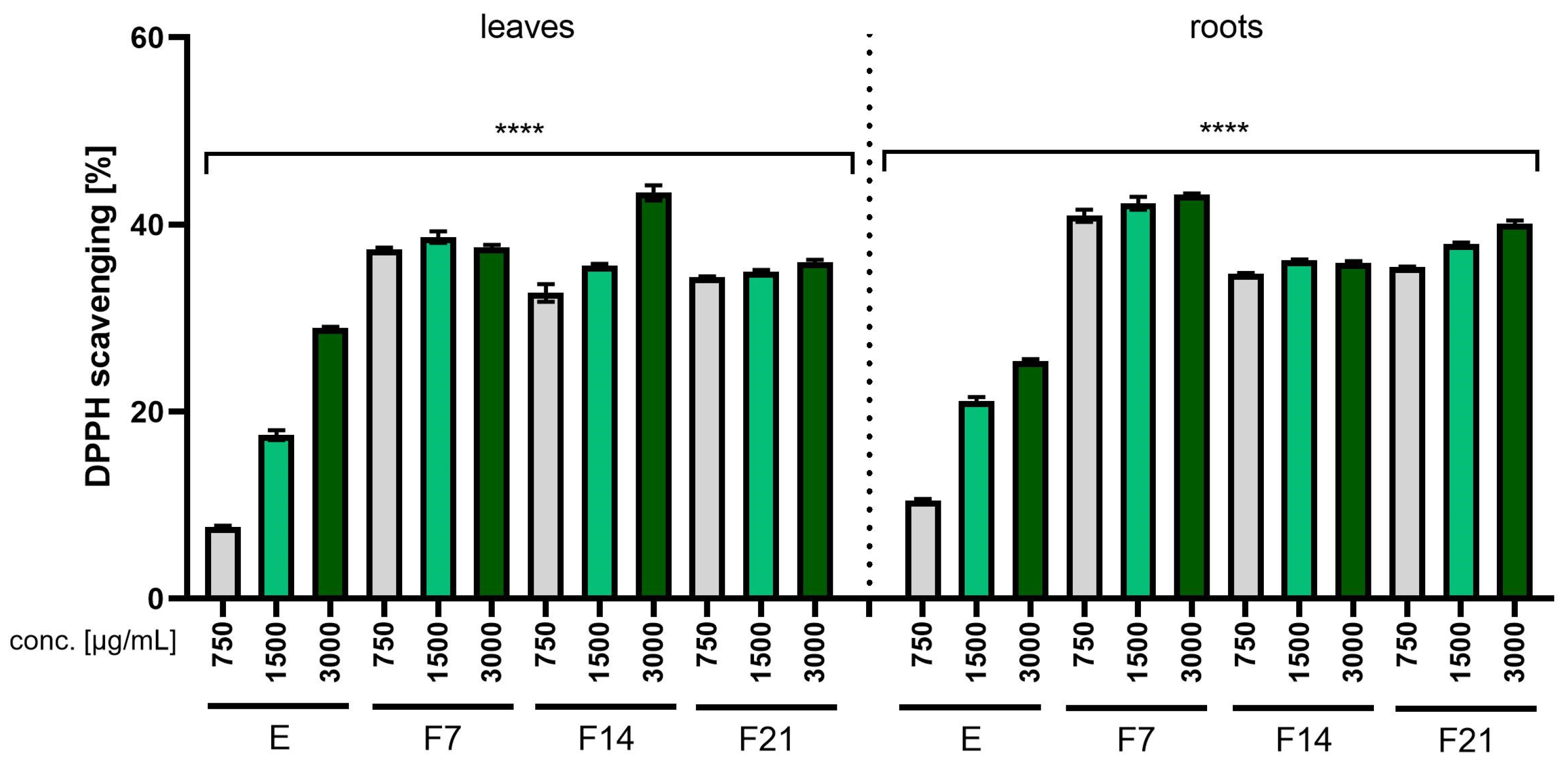


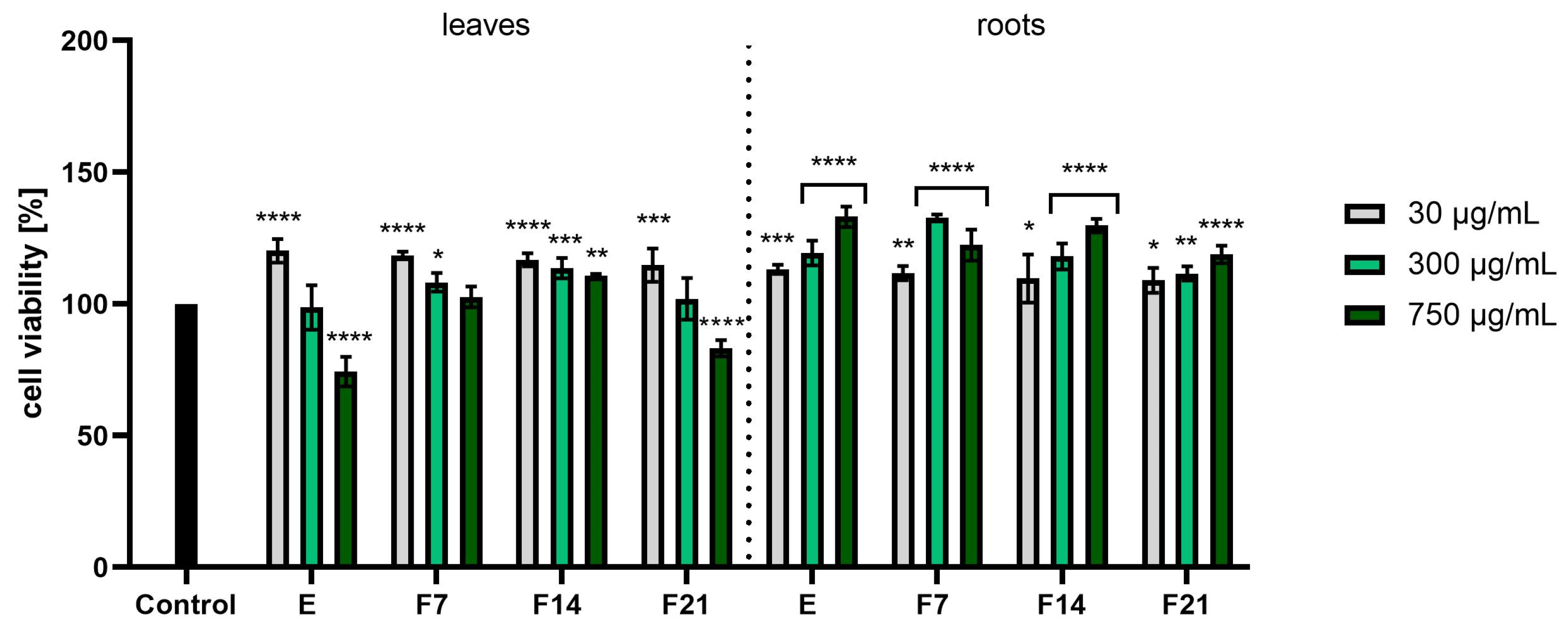
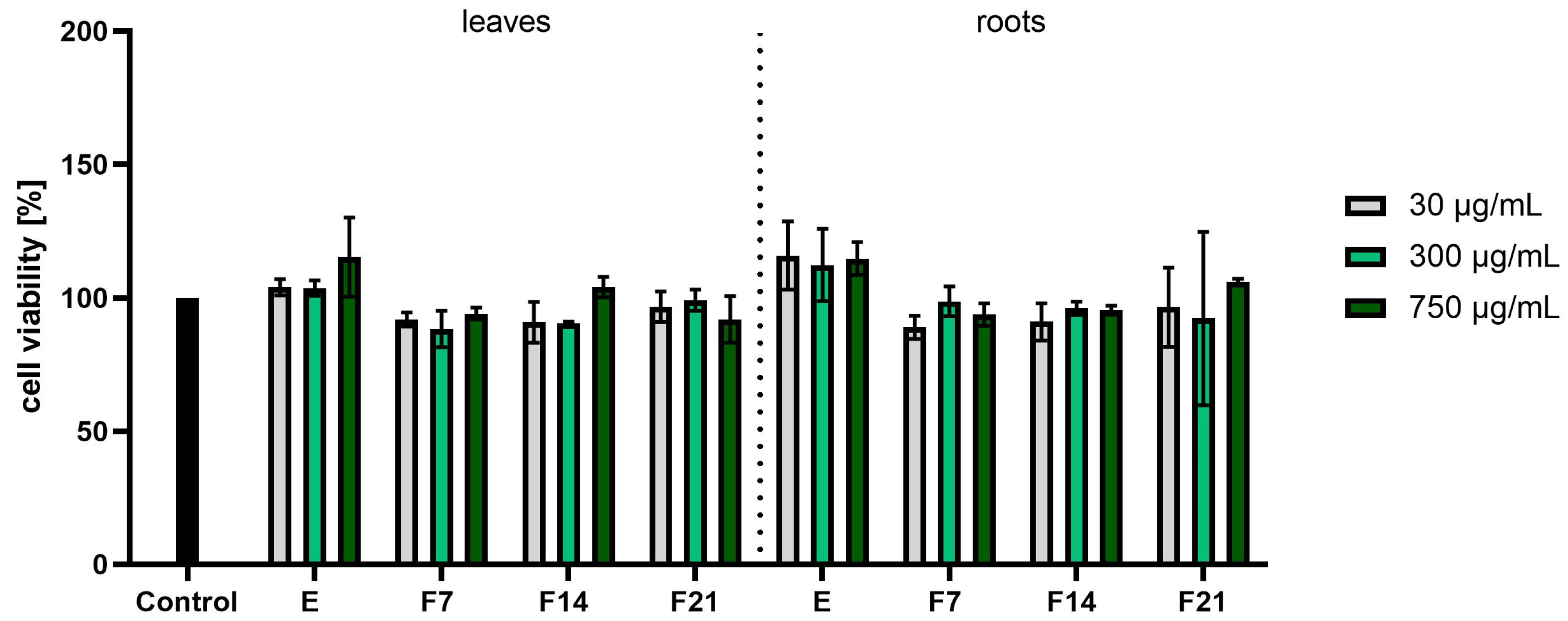
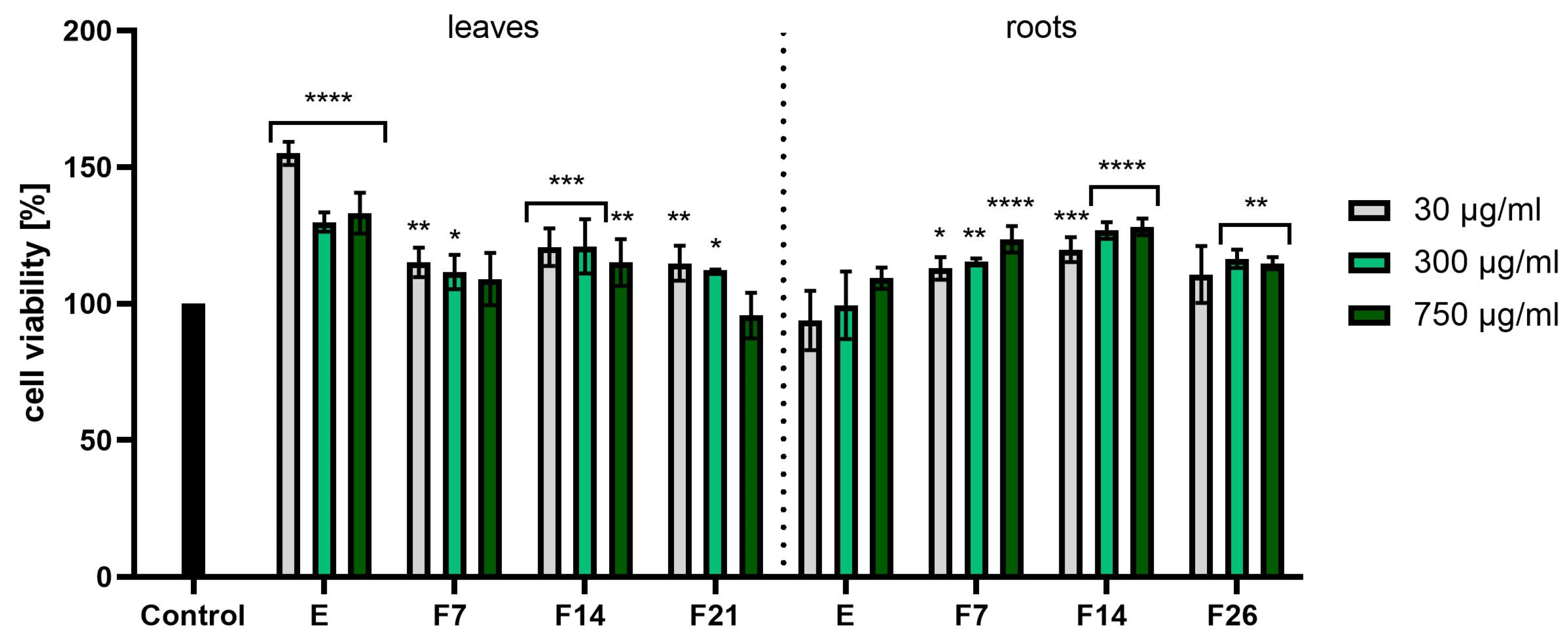
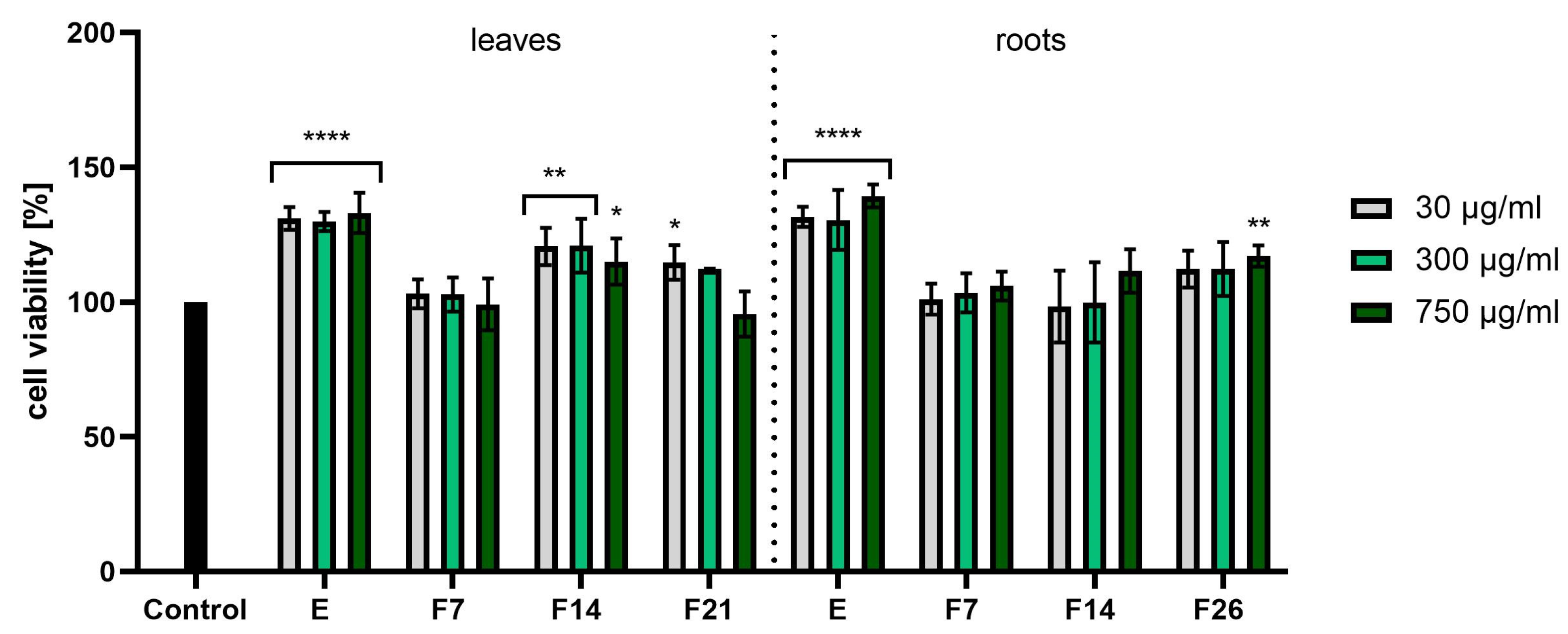
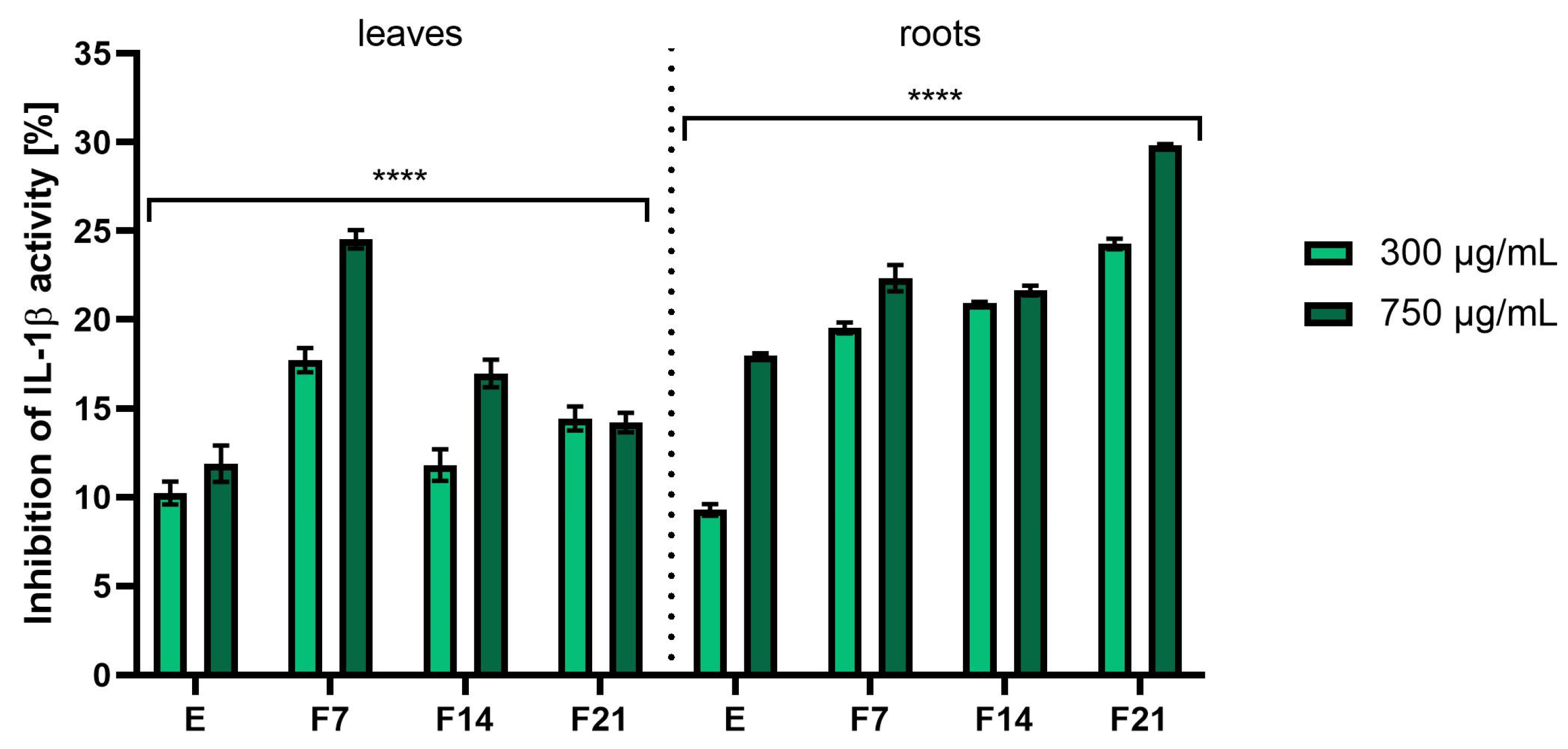

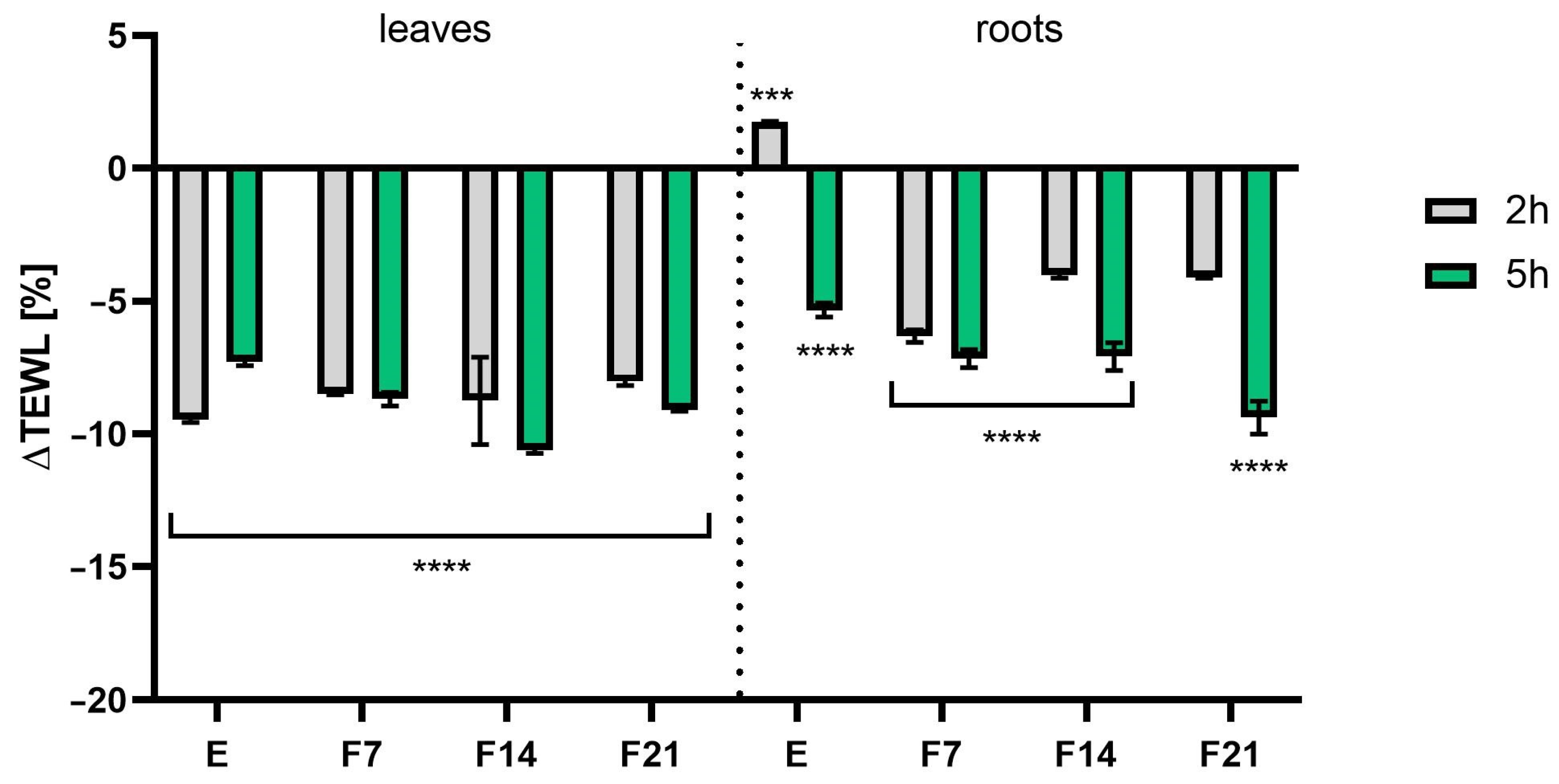
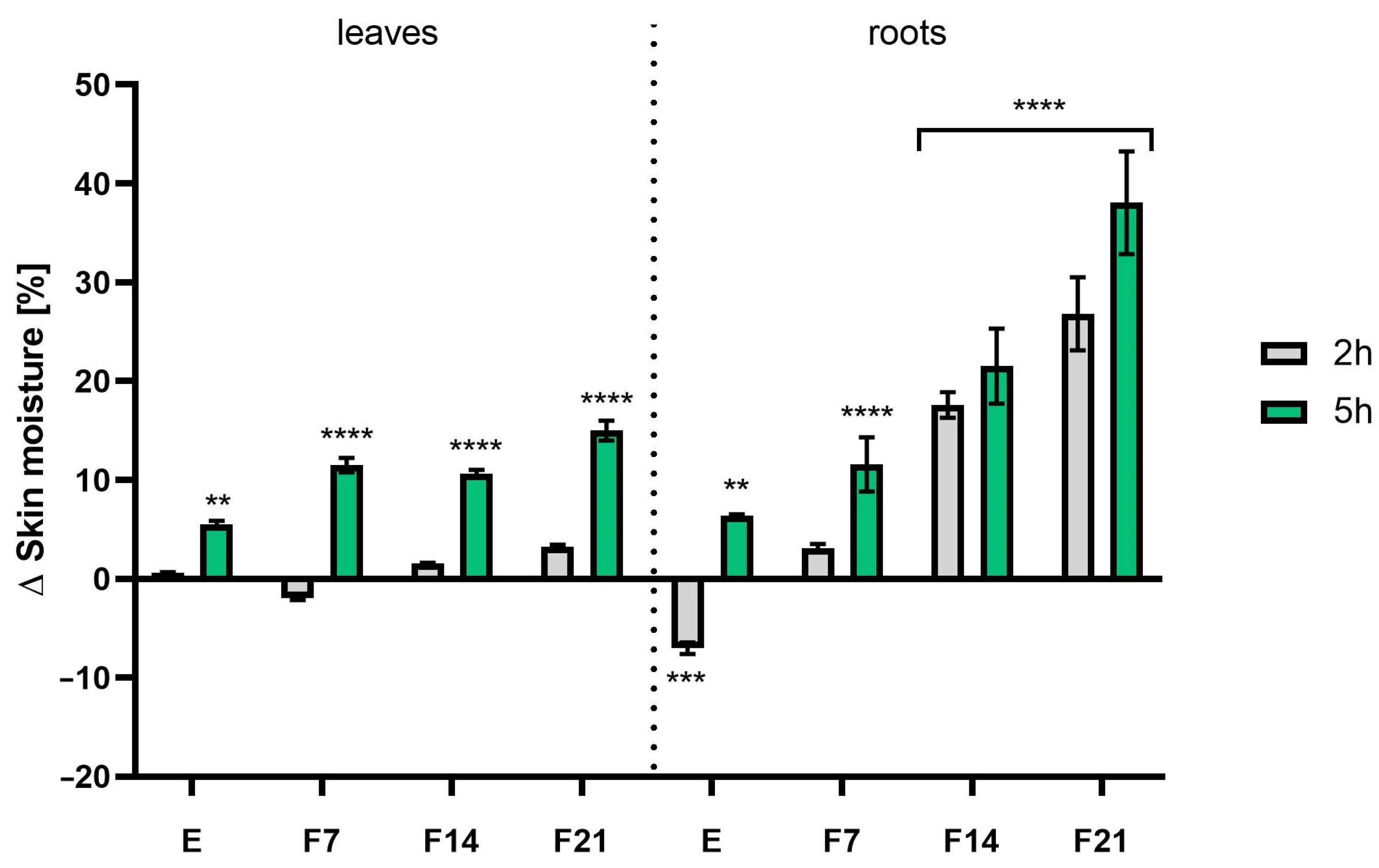
| Rt (min) | Observed Ion Mass [M-H]-/(Fragments) | Δ ppm | Formula | Identified | Extract (µg/mL) | Ferment 7 | Ferment 14 | Ferment 21 |
|---|---|---|---|---|---|---|---|---|
| 1.49 | 195.05182 | 4.05 | C6H12O7 | Gluconic acid | - | +++ | +++ | +++ |
| 3.75 | 169.01443 (125) | 1.08 | C7H6O5 | Gallic acid | - | 0.94 ± 0.04 a | 1.44 ± 0.08 b | 2.05 ± 0.09 c |
| 6.17 | 315.07299 (153) | 2.64 | C13H16O9 | Dihydroxybenzoic hexoside | + | + | + | + |
| 7.68 | 305.06789 | 3.97 | C15H14O7 | Gallocatechin | - | + | + | + |
| 12.72 | 305.06731 | 2.07 | C15H14O7 | Gallocatechin | - | 24.92 ± 1.25 a | 24.28 ± 1.11 a | 23.95 ± 1.45 a |
| 13.28 | 289.07189 | 0.44 | C15H14O6 | Catechin | - | 8.18 ± 0.44 a | 7.97 ± 0.39 a | 7.89 ± 0.31 a |
| 17.38 | 289.07256 | 2.75 | C15H14O6 | Epicatechin | - | 5.9 ± 0.34 a | 7.74 ± 0.31 b | 8.11 ± 0.39 b |
| 17.68 | 295.04569 (179.133) | −0.85 | C13H12O8 | Caffeoylmalic acid | 4.94 ± 0.25 a | 3.71 ± 0.14 b | 3.72 ± 0.21 b | 4.08 ± 0.20 b |
| 21.31 | 279.05119 (163.133) | 0.58 | C13H12O7 | p-coumaroylmalic acid | 6.53 ± 0.31 a | 4.46 ± 0.22 b | 4.58 ± 0.21 b | 5.11 ± 0.26 c |
| 24.16 | 309.06198 (193.133) | 1.25 | C14H14O8 | Feruloylmalic acid | 4.65 ± 0.25 a | 3.61 ± 0.18 b | 3.41 ± 0.17 b | 3.82 ± 0.20 b |
| 28.06 | 593.15188 (283.447) | 1.15 | C27H30O15 | Kaempferol-3-O-glucoside-7-O-rhamnoside | 4.91 ± 0.22 a | 4.93 ± 0.23 a | 4.91 ± 0.21 a | 5.15 ± 0.26 a |
| 29.17 | 609.14650 | 0.64 | C27H30O16 | Rutoside | + | 1.54 ± 0.01 a | 2.07 ± 0.05 b | 2.12 ± 0.04 b |
| 30.32 | 593.15081 (283) | −0.65 | C27H30O15 | Kaempferol-3-rutoside | 5.88 ± 0.31 a | 5.15 ± 0.22 b | 5.76 ± 0.23 a | 5.88 ± 0.25 a |
| 31.40 | 563.14124 (283) | 1.08 | C26H28O14 | Kaempferol derivatives | 4.03 ± 0.20 a | 3.17 ± 0.16 b | 3.92 ± 0.18 a | 3.98 ± 0.17 a |
| 36.71 | 577.15698 (284.431) | 1.21 | C27H30O14 | Kaempferitrin | 9.57 ± 0.51 a | 8.67 ± 0.48 a | 9.46 ± 0.41 a | 10.03 ± 0.55 a |
| 37.98 | 887.22917 (283) | 4.53 | C41H44O22 | Kaempferol derivatives | + | + | + | + |
| 55.22 | 327.21887 | 3.57 | C18H32O5 | Fatty acid deriv. | ++ | ++ | ++ | ++ |
| 58.93 | 329.23440 | 3.19 | C18H34O5 | Fatty acid deriv. | ++ | ++ | ++ | ++ |
| 64.79 | 331.24989 | 2.69 | C18H36O5 | Fatty acid deriv. | +++ | ++ | ++ | ++ |
| 65.86 | 265.14508 | 2.06 | C15H22O4 | Fatty acid deriv. | +++ | ++ | ++ | ++ |
| Rt (min) | Observed Ion Mass [M-H]-/(Fragments) | Δ ppm | Formula | Identified | Extract (µg/g) | Ferment 7 | Ferment 14 | Ferment 21 |
|---|---|---|---|---|---|---|---|---|
| 1.49 | 195.05170 | 3.44 | C6H12O7 | Gluconic acid | + | ++ | ++ | +++ |
| 3.81 | 169.01451 (125) | 1.55 | C7H6O5 | Gallic acid | - | 0.68 ± 0.11 a | 1.16 ± 0.07 b | 1.71 ± 0.03 c |
| 7.68 | 305.06795 | 4.16 | C15H14O7 | Gallocatechin | - | 2.61 ± 0.16 a | 2.53 ± 0.17 a | 4.18 ± 0.09 b |
| 12.74 | 305.06748 | 2.63 | C15H14O7 | Gallocatechin | 7.03 ± 0.10 a | 14.86 ± 0.45 b | 24.15 ± 1.38 c | 22.02 ± 0.41 c |
| 13.31 | 289.07204 | 0.96 | C15H14O6 | Catechin | - | 1.46 ± 0.03 a | 1.76 ± 0.07 b | 3.41 ± 0.16 c |
| 17.38 | 289.07273 | 3.34 | C15H14O6 | Epicatechin | + | 5.63 ± 0.06 a | 6.40 ± 0.12 b | 8.04 ± 0.12 c |
| 29.16 | 609.14663 | 0.85 | C27H30O16 | Rutoside | - | 0.87 ± 0.01 a | 0.85 ± 0.04 a | 0.98 ± 0.03 b |
| 29.81 | 463.08835 | 0.32 | C21H20O12 | Quercetin glucoside | 0.21 ± 0.01 a | 0.19 ± 0.01 a | 0.23 ± 0.01 b | |
| 30.34 | 933.26412 | −1.92 | C43H48O23 | Pelargonidin deriv. | + | + | + | + |
| 35.57 | 1019.26477 | −1.51 | C46H50O26 | Pelargonidin deriv. | ++ | ++ | ++ | ++ |
| 40.89 | 1019.26610 | −0.20 | C46H50O26 | Pelargonidin deriv. | ++ | +++ | +++ | +++ |
| 43.32 | 723.50602 | 1.03 | C41H72O10 | Unidentified | +++ | +++ | +++ | +++ |
| 48.44 | 836.58678 | 0.38 | C44H85O14 | Unidentified | +++ | +++ | +++ | +++ |
| 55.39 | 327.21887 | 3.57 | C18H32O5 | Fatty acid deriv. | + | + | + | + |
| 58.93 | 329.23440 | 3.19 | C18H34O5 | Fatty acid deriv. | + | + | + | + |
| 64.81 | 331.25007 | 3.23 | C18H36O5 | Fatty acid deriv. | +++ | ++ | ++ | ++ |
| 65.89 | 265.14508 | 2.06 | C15H22O4 | Fatty acid deriv. | +++ | ++ | ++ | ++ |
| Test Microorganism | Minimum Inhibitory Concentrations (MIC) [µg/mL] | |||
|---|---|---|---|---|
| Extract | Ferment 7 | Ferment 14 | Ferment 21 | |
| Staphylococcus aureus | 100 | 100 | 50 | 100 |
| Staphylococcus epidermidis | nd | nd | nd | nd |
| Staphylococcus capitis | nd | nd | 800 | 1000 |
| Micrococcus luteus | 400 | 100 | 100 | 200 |
| Corynebacterium xerosis | nd | nd | nd | nd |
| Yersinia enterocolitica | 200 | 200 | 50 | 50 |
| Pseudomonas aeruginosa | 50 | 100 | 50 | 50 |
| Test Microorganism | Minimum Inhibitory Concentration (MIC) [µg/mL] | |||
|---|---|---|---|---|
| Extract | Ferment 7 | Ferment 14 | Ferment 21 | |
| Staphylococcus aureus | 400 | 200 | 100 | 100 |
| Staphylococcus epidermidis | 400 | 600 | 400 | 400 |
| Staphylococcus capitis | nd | nd | 800 | 1000 |
| Micrococcus luteus | 50 | 50 | 50 | 50 |
| Corynebacterium xerosis | 600 | 400 | 400 | 200 |
| Yersinia enterocolitica | 100 | 50 | 50 | 50 |
| Pseudomonas aeruginosa | 600 | 600 | 400 | 400 |
Disclaimer/Publisher’s Note: The statements, opinions and data contained in all publications are solely those of the individual author(s) and contributor(s) and not of MDPI and/or the editor(s). MDPI and/or the editor(s) disclaim responsibility for any injury to people or property resulting from any ideas, methods, instructions or products referred to in the content. |
© 2024 by the authors. Licensee MDPI, Basel, Switzerland. This article is an open access article distributed under the terms and conditions of the Creative Commons Attribution (CC BY) license (https://creativecommons.org/licenses/by/4.0/).
Share and Cite
Ziemlewska, A.; Zagórska-Dziok, M.; Mokrzyńska, A.; Nizioł-Łukaszewska, Z.; Szczepanek, D.; Sowa, I.; Wójciak, M. Comparison of Anti-Inflammatory and Antibacterial Properties of Raphanus sativus L. Leaf and Root Kombucha-Fermented Extracts. Int. J. Mol. Sci. 2024, 25, 5622. https://doi.org/10.3390/ijms25115622
Ziemlewska A, Zagórska-Dziok M, Mokrzyńska A, Nizioł-Łukaszewska Z, Szczepanek D, Sowa I, Wójciak M. Comparison of Anti-Inflammatory and Antibacterial Properties of Raphanus sativus L. Leaf and Root Kombucha-Fermented Extracts. International Journal of Molecular Sciences. 2024; 25(11):5622. https://doi.org/10.3390/ijms25115622
Chicago/Turabian StyleZiemlewska, Aleksandra, Martyna Zagórska-Dziok, Agnieszka Mokrzyńska, Zofia Nizioł-Łukaszewska, Dariusz Szczepanek, Ireneusz Sowa, and Magdalena Wójciak. 2024. "Comparison of Anti-Inflammatory and Antibacterial Properties of Raphanus sativus L. Leaf and Root Kombucha-Fermented Extracts" International Journal of Molecular Sciences 25, no. 11: 5622. https://doi.org/10.3390/ijms25115622





